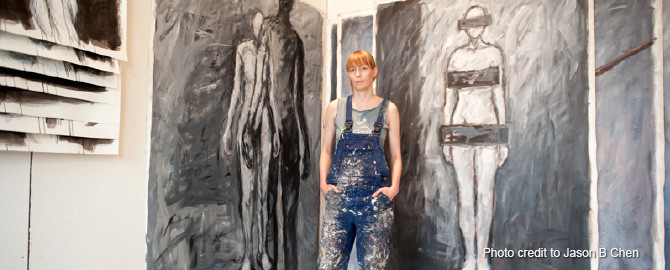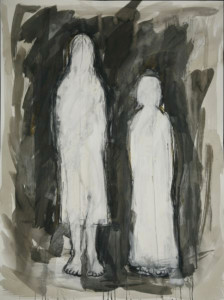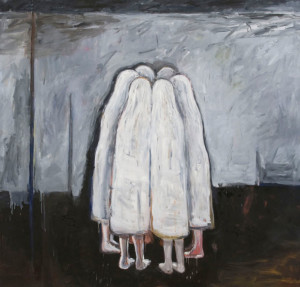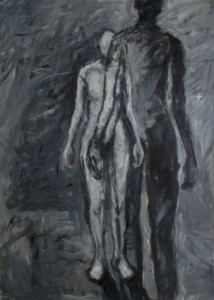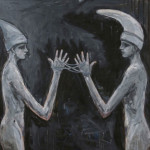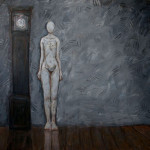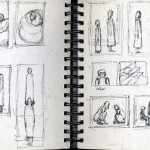Anki King’s paintings harness an awkward presence. Her figures are life-size; they loom, dominate and have an obstinate stillness. They are simple, in parts exaggerated, and are completely devoid of animation or energy. It is this for this reason that we are drawn in, our curiosity spiked by the mystery.
In 2010 King was awarded the London Creative Competition “Artist of the Year” for her painting titled “Figure”. Her work is represented in the collection of the Appleton Museum of Art and her exhibition venues have included Katonah Museum of Art, Las Cruces Museum of Art, Karpeles Library Museum and the Metropolitan Museum of Art in Tokyo. She frequently exhibits in both New York and in Norway.
Can you please introduce yourself and explain what motivated you to become an Artist?
My name is Anki King. I grew up in a small town called Harestua in Norway. Harestua is 45 minutes north of Oslo. Even though I was drawing all the time throughout my youth, I never considered drawing or art as something I could build my life around as an adult. I had very little exposure to art as a kid and there weren’t any artists in my family or in my town, so the idea of becoming an artist wasn’t something I had in mind, even though there is a wonderful story in my family about how my grandmother was almost painted by Edvard Munch when she was a little girl. I don’t think this had much effect on my future direction, although I might be wrong about that!
As I was approaching adulthood, my first career plan was to study economics and then find a job that paid well. After three boring years of economics, I decided to sign up for practical arts and loved it. So, I moved to Oslo and enrolled in a proper art school. During my time there, I realized that I was an artist and that I should build my life around art. I moved to New York City when I was 24. Even though being an artist is hard at times, I can’t imagine any other way of life.
I consider myself a painter primarily, but I also make sculpture. I prefer to work with oil paint. I used to paint from photographs that I would take myself. 10 years ago, I stopped painting from photos and began working exclusively from imagination. That was a difficult transition. Finding trust in the process of working only from the imagination and in the material qualities of paint took a lot of effort and time. Now this way of working is what makes the process so exciting and rewarding.
Obviously the human figure has been a huge muse for many artists throughout the history of art. What artists or professionals have been your biggest influences?
My influences have changed as I’ve grown. When I was in art school, I was focused on developing skills and was impressed and inspired by figure painters like Lucian Freud, Edward Hopper, and Alice Neel. But I also always admired “painterly painting” – meaning work where mimicking reality is not the focus, but rather about using paint to create an image. The work I enjoy most is when I feel that the skill and training of the artist is strong, but secondary to the searching and questioning they do through their work.
Artists who I think about a lot lately are more abstract, but almost all have figurative elements too; Susan Rothenberg, Terry Winters, Katherine Bradford, Philip Guston, and Marsden Hartley to name a few. I recently got the Menil Collection’s Forrest Bess exhibition catalog and I’m completely fascinated. For a long time, I was also carefully looking at the Bay Area artists – mostly Nathan Oliveira and the sculptor Manuel Neri.
What are you trying to communicate through your art?
I believe that I mostly work on an inner communication, a communication with a non-verbal self that I do not know and that I have a deep curiosity for. It is an intense search for answers to questions I don’t even know I have. There are always images coming into my head and I jot them down in my drawing book or whatever I have at hand and I do not attempt to connect words to the ideas until the painting has been created and possibly even become a completely different image. Then I sit down and look at it. It is in many ways as new and strange to me then as to anyone seeing it for the first time. This keeps it magical and exciting for me. I am always thrilled to hear other people respond to the work because it contributes to my own understanding and inevitably broadens the meaning of the work.
What do you think an artist can show the world through Art, does it connect with the world creating further understanding?
I attempt to make visible parts of myself that I don’t already know and, by doing so, it is possible that I also find a deeper part of humanity. On the most basic level we are all connected and we are literally sharing atoms and energy and so the deeper you go, the more you can reveal about everyone’s world. As someone once told me, “The more personal you are, the more universal you are.”
If someone seeing the work connects with it and gains some insight into themselves, then ultimately art can help grow empathy, since the more completely one knows oneself, the more one can relate to others. Or on the other side of the spectrum, big bold works can certainly help bring a public focus to a specific issue.
What future plans do you have? What projects would you like to accomplish?
I hope to make better and better paintings as I am always studying art, science, psychology and life and bringing every piece of this to my work. I’m looking forward to doing more sculptural work. I have plans to do large-scale sculptures outside in the landscape. The part of nature that human nature belongs to is something I will continue to delve into and explore.
Born near Oslo, Norway in 1970. In 1991 Anki King was accepted in the three year program at Oslo Drawing and Painting School before moving to New York in 1994. Currently King lives and works in New York City.
All images courtesy of Anki King | www.ankiking.com
For more information on Hong Kong Art Tutoring please contact:
Gail Deayton
Telephone: +852 9722 8353
Email: info@hkarttutoring.com

